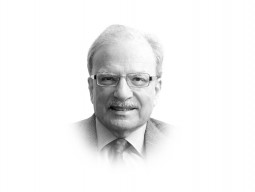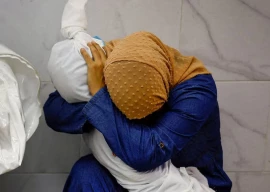
It should not come as a surprise that the subcontinent’s ruling groups are experienced masters at using ‘national security’ and ideologies of difference to perpetuate enmity between peoples. The word ‘con’ is right there in the middle of the ‘subcontinent’. The transfer of power in 1947 created enduring myths of glory in entities to which the British transferred their power. The simultaneous partition of the sub-continental British territories also created other more pernicious myths of ‘self’, ‘friend’ and ‘enemy’. These powerful schemes hatched from the deepest bowels of the deep state have been around for some time now. With the right combination of propaganda and guns, carrots and sticks, awards and torture, celebrations and prison terms, pursued doggedly over decades, these projects have started bearing poisonous fruits to whose tastes we have grown attached. The nation states of the subcontinent have ‘matured’. Selfhoods have been forcibly beaten into post-Partition ‘national’ shapes to serve the interests of the mandarins sitting in Delhi, Dhaka and Islamabad. This is a crime of epic proportions. People pay for it by being killed, maimed and silenced for not toeing the line in silence. As a collective, we pay for it by accepting the death of dreams and possibilities of plural and interwoven loyalties and loves as absurd.
It must be the shallowness of our imagination and memory that we think it is ‘natural’ that our respective unitary nation states demand that loyalty, longing and love should end at the Radcliffe border with clinical precision. In 1971, a struggle made some of these clean-cut things fuzzy. This was the movement leading up to the independence of the landmass that now calls itself the People’s Republic of Bangladesh. It is true that the Indian Union and many of its peoples were supportive of East Bengal’s struggle for independence. But there was something in the enthusiasm of the Bangladesh solidarity initiatives in West Bengal that didn’t quite fit into the neat India-Bangladesh narrative. West Bengal was ‘closer’ to East Bengal in a way that Mizoram wasn’t. This kind of closeness runs against the grain of nation state narratives emanating from Delhi but in reality, often the least embarrassing reaction to such closeness is to publicly ignore it. Think about how Delhi reacts to resolutions about Eelam Tamils in the Tamil Nadu Assembly. Think about what Kabul or Peshawar think about the Durand Line and Islamabad’s attitude towards that narrative.
I am talking of a bygone moment. This ‘special’ closeness that poured out in West Bengal in 1971 does not exist anymore as West Bengal has also learned to look east through a Delhi lens. This erstwhile special closeness was spontaneous. Delhi knew of this ‘affair’ — something that wasn’t quite infidelity or ‘disloyalty’ but a complicated kind of lopsided polyamory that only unfortunate victims of Partition zones can relate to. It is a love that dare not tell its name in a subcontinent divided into nation states that demand total fidelity and loyalty not only in public but also in realms of fantasy. Gobindo Haldar was one such lover. He died on January 17 in Kolkata aged 84 in a very modest healthcare facility. He was born in Bongaon, Jessore district, Bengal. Jessore was one of districts that were partitioned up to the thana level. Bongaon ‘fell’ in the Indian Union. Gobindo worked in the income tax department but was a lyricist for Akashbani, India’s national public radio broadcaster. Later, when the Swadhin Bangla Betar Kendra (Free Bengal Radio) was set up by the Bangladesh government-in-exile, Gobindo was asked by Kamal Ahmed to write songs for Free Bengal Radio. And he wrote what became words that stirred a people. The most famous songs he wrote include “Mora Ekti Phulke Bachabo Bole Juddho Kori” (We fight to save one flower), “Purbo Digonte Surjo Uthechhe Rokto Lal” (A red sun has risen in the eastern horizon) and “Padma Meghna Jamuna Tomar Amar Thikana” (The land of Padma, Meghna, Jamuna rivers is where you and I belong). The name of the last song comes from a famous political slogan that was posited against the Pakistan-loyalist religious slogan “Tomar Amar Thikana Praner Bhumi Madina” (Beloved land of Madina is where you and I belong). I have a picture of him holding a Bangladesh flag to his chest.
He was from a different universe, representing a different universe of ‘loyalty’. He lived amongst us, in West Bengal, in the Indian Union. And we did not care, because we are prisoners of divisive ‘national’ narratives that make us smaller as humans. How many such people are there? Let us look around. Let us expand and see the many fights for justice all around us for what they are, for Cornel West says that justice is what love looks like in public. Let us salute such lovers and have the humanity to criticise ideologies that deem saluting love as ‘illegal’. Let us learn to listen to the illicit whispers of Gobindo Haldar. One of the many clues to this subcontinent’s salvation may lie there. After all, this fecund land also teaches to love as did Shah Abdul Karim — “Bondhe maya lagaise, piriti shikhaise, dewana banaise, ki jadu koriya bondhe maya lagaise” (My friend has entranced me, has taught me love, has made me diwana, had entranced me by some magic).
Published in The Express Tribune, January 22nd, 2015.
Like Opinion & Editorial on Facebook, follow @ETOpEd on Twitter to receive all updates on all our daily pieces.
COMMENTS (10)
Comments are moderated and generally will be posted if they are on-topic and not abusive.
For more information, please see our Comments FAQ
































































John B, It's popular press that lampoons WB, data say a different story. That Bengal's growth rate is a lot higher than national average is an established fact (http://timesofindia.indiatimes.com/india/Puducherry-Meghalaya-clock-over-10-growth/articleshow/43946807.cms), please suit yourself finding the data. Liabilities in excess of output whatever that means is true also for Punjab Kerala etc if you mean the debt burden.
@stclemson: Sorry. I don't agree with the popular press opinions. I need data.
Here is a data sheet from the planning commission of GoI. There are many other information in planning commission website.
W. Bengal liabilities and growth rate is lower than other states. Much of the growth of the state is from Agriculture and service sectors, which you can find in other links.
The state liabilities are in far excess of its output. I agree with the many of the reasons you cited, but that can't be an excuse.
http://planningcommission.nic.in/data/datatable/data_2312/DatabookDec2014%20171.pdf
John B, You are sorely mistaken. West Bengal gives more to the central government kitty than receives back. This is true only for a handful of states as you can check from the Govt. of India website. Economic performance is a lot better than national average despite a shortage of land due to 3 times higher population density caused by, you guessed it, partition and the resultant influx of refugees from 1947 onwards. http://www.firstpost.com/business/macau-tops-economic-performance-globally-kolkata-beats-mumbai-india-2058779.html
@Jyoti Malhotra:
No one ever asked the people of any state where their new home should be when the British empire / influence was collapsing , either in Middle east, Africa, or in British India. Neither the millions of poor Muslims nor the millions of poor Hindus had anything to do with partition decision. The choices were made for them, even in 1971. Looking back, it was not a bad decision.
In an ideal political climate the subcontinent should be a federation of states with equal power, but ......
Bengal intellectuals should cast their pens away in their utopian dream, and should write about how to improve the economy of the state for the millions of poor. The people of other states cannot continue to subsidize the day dream socialism of W.Bangal.
Garga Chatterjee : Sir, Bangladesh is a fabulous Democratic and Secular Country. People like you should migrate to Bangladesh and Spread Love between Muslims and Hindus. The Hindu Population of East Pakistan now Bangladesh was : in 1941 - 28%, In 1951 - 22%, in 1974 it was 13.5%, in 2001 - 9.2%. By now in 1915 I am sure it will be around SIX PERCENT. I am sure you will enjoy the Democratic and Secular atmosphere of Bangladesh! . Mods are requested to allow this post as it will please Mr. Garga Chatterji.
The Hindus of Bangladesh stayed behind in East Pakistan and now in Bangladesh -- about 10 million moved during the 1971 war -- unlike in Pakistan. Yes we should look at "stark naked history" as Someone says, so here it is : Nobody asked the people of Bengal whether they wanted partition, especially as it was Bengal which succeeded in reversing an earlier partition undertaken by Curzon in 1905. When partition happened in 1947, Bengalis were not only asked, but they did an even braver thing in 1971, they broke away from their religious loyalty to "Pakistan" and created a new country
What the heck did I just read?
People like the author live in their own world. He should talk to the hindus of Bangladesh, that should be enough for him get back to the real world. If the people of east bengal had any love for west bengal, there would not have been any partition. Their loyalty was with their religion and not tk the people of other religion. Problem is, people like author romaticize a lot without looking at stark naked history.
Bravo!
In case the readers are wondering what the heck this opinion is about , here is a summary of my understanding.
"West Bengal was ‘closer’ to East Bengal in a way that Mizoram wasn’t. " and it was New Delhi that separated the west Bengal from becoming one Bengal with the then east Bengal in 1971 and thereafter.
All the poets talked about love of the land and people and how wonderful it is and was and so on, and it was the Radcliffe and stubborn Delhi that spoiled the fun of the people of Bengal.
My mind cannot understand any further. Please help me.